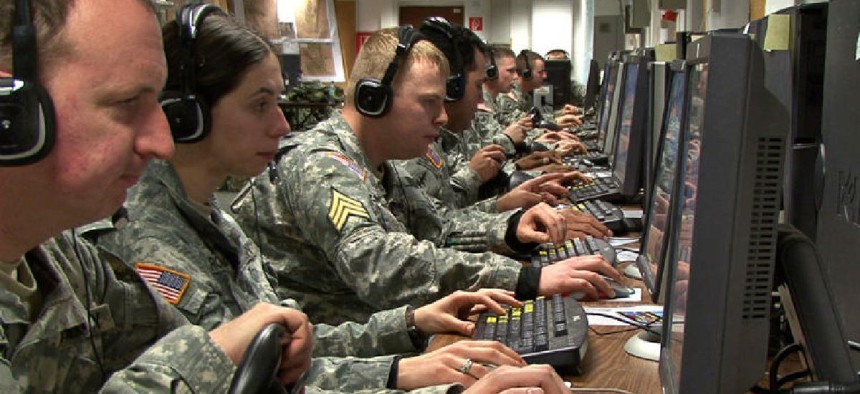Army seeks new paths to network interoperability
The Army doesn't want to keep relying on the Defense Department's secret networks to collaborate with international mission partners, but the change faces some policy hurdles.
The Army doesn't want to keep relying on the Defense Department's secret networks to collaborate with international mission partners, but the change faces some policy hurdles.
Maj. Gen. Douglas Crissman, director of the Mission Command Center of Excellence, said that when it comes to materiel, be it hardware or software, the Army may have to update policy and doctrine governing how it operates once it fully adopts the secure-but-unclassified architecture of the burgeoning Integrated Tactical Network.
"Most of it is trying to mature our materiel solutions to make us more comfortable getting off of the secret, SIPRNET, as our primary warfighting enclave," Crissman told Defense Systems.
The Army's network capabilities have easily been one of the service's biggest points of contention in recent years, which is why it's a prominent modernization effort. ITN uses both secret and secure-but-unclassified networks, but shifting to depend more on the latter presents significant challenges.
Gen. John Murray, head of Army Futures Command, spoke to that during an Oct. 14 media briefing at the Association of the U.S. Army's annual conference in Washington, D.C.
"The thing that I think about often is the network. It's not problems within the network, it's that we're relying on the network for so much," Murray said, adding that many of the command's focus areas, such as the Integrated Visual Augmentation System training tool, rely on network capabilities. "The bandwidth requirements, the latency we can't have -- so there's a lot of technical hurdles to overcome."
The Army's Network Cross Functional Team is tasked with solving interoperability issues as it works to employ the ITN concept, which seeks to make the service's tactical network by faster, cohesive and more agile by using commercially available tech and existing environment. But as the service embraces interoperability, it has become clear that policy changes are also needed.
Secure-but-unclassified networks allow warfighters to connect to 4G and LTE cellular networks, advanced waveforms and satellite communications, as well as being simply easier to use. Crissman said the move to secure-but-unclassified doesn't mean Secret Internet Protocol Router Network (SIPRNET) or the Joint Worldwide Intelligence Communications System (JWICS) would be eradicated, but their rigidity may be impeding battlefield communications.
"We're not suggesting that we take away the SIPRNET or the JWICS, which is the top secret network — we'll always need that," Crissman said. "But instead of it being the default network everybody is on and none of our partners can access, we're suggesting that we go to a mission-secret or [North American Treaty Organization]-secret, secret-releasable, type of enclave," and have fewer people on the classified networks.
But there's still the question, he said, of surmounting current policy and creating an alternative with the ITN.
Greg Grzybowski, a former Army officer and business development manager for the cyber warfare campaign at Raytheon, told Defense Systems that because every mission is different, policies and authorities will likely need to be continuously evaluated.
"The idea is that you have to share some of that information with our allies if we're doing a multinational operation together. And so the challenge with that is policy and authorities because every nation has a different definition or set of conditions for the different levels of command," Grzybowski said. "That's what they're working through: How do you sync up when in any one mission you can have different sets of national partners."
Crissman said the policy hiccups more so represent an evolution in materiel solutions, which can be a good thing.
"As we improve and modernize our materiel solutions, some of those materiel solutions may allow us to bridge policy gaps that previously existed or previously didn't exist," Crissman said.
For example, cross-domain hardware solutions facilitate data flow between classification levels but need to be certified individually. "We would potentially have some policy adjustments that we would need to make to make sure that as we share information and we designate rules and processes to share that information using this new equipment, we have to make sure we have the appropriate doctrine," Crissman said.
Those policy tweaks to current sharing procedures, protocols and guidelines of various intelligence agencies, such as with NATO, would be made continuously as different tools are introduced and adopted.
"It's not something where sometime next year we can flip a switch and say the whole Army is going from SIPR to something else or something less," Crissman said. "We've got to establish an enterprise conditions first."
The director of the Army's Network Cross Functional Team, Maj. Gen. Pete Gallagher, said the team is working with senior Army staff, the Joint Staff and the Office of the Secretary of Defense to untangle policy snags surrounding secure-but-unclassified architecture.
"We're also looking to policy adjustments because for the most part, what we've been operating on is the national secret or SIPRNET with all of our warfighting functions, and that has some limitations," Gallagher told reporters during an Oct. 15 briefing at AUSA.
"We're looking at do we go with a mission secret where our network is releasable to coalition mission partners as a matter of practice and ... do we adjust policy going forward from both the principal warfighting network? Do we make adjustments there or do we adjust any of our foreign disclosure requirements?"
And while technical challenges do exist, the biggest impact will be on what people buy, Grzybowski said.
"I think there will be a technical impact, not because the technology isn't there, but because people have invested in certain paths based on certain authorities, and if we change that then some nations may have to make some adjustments to make an interoperable kit," he said.
This article first appeared on FCW, a partner site of Defense Systems.






